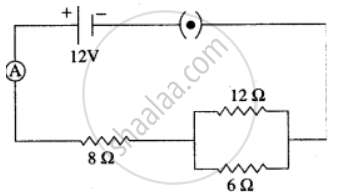Advertisements
Advertisements
Question
Three resistors are connected to a 12 V battery as shown in the figure given below:

(i) What is the current through the 8 ohm resistor?
(ii) What is the potential difference across the parallel combination of 6 ohm and 12 ohm resistor?
(iii) What is the current through the 6 ohm resistor?
Solution
(i) 6 ohm and 12 ohm are connected in parallel, So
⇒ `1/"R"_1 = 1/6 + 1/12 = (2 + 1)/12 = 3/12`
⇒ `1/"R"_1 = 1/4`
R1 = 4 ohm.
∴ Total Resistance R = 8 + 4 = 12 ohm.
Now ∵ V = IR
⇒ 12 = I × 12
∴ I = 1 Amp.
(ii) V = IR = 1 ×4 = 4 Volt
(iii) ∵ V = I1R
⇒ 4 = I1 × 6
∴ I1 = `4/6`
= 0.66 Amp.
APPEARS IN
RELATED QUESTIONS
How much energy is given to each coulomb of charge passing through a 6 V battery?
The values of current (I) flowing through a given resistor of resistance (R), for the corresponding values of potential difference (V) across the resistor are as given below:
| V (volts) | 0.5 | 1.0 | 1.5 | 2.0 | 2.5 | 3.0 | 4.0 | 5.0 |
| I (amperes) | 0.1 | 0.2 | 0.3 | 0.4 | 0.5 | 0.6 | 0.8 | 1.0 |
Plot a graph between current (I) and potential difference (V) and determine the resistance (R) of the resistor.
Which device is used to measure p.d?
How is a voltmeter connected in the circuit to measure the potential difference between two points? Explain with the help of a diagram.
Name a device which helps to maintain potential difference across a conductor (say, a bulb).
In the circuit shown below:

The potential difference across the 3 Ω resistor is:
Exercise.
Calculate the amount of charge that would flow in 2 hours through an element of an electric bulb drawing a current of 2.5 A.
A boy records that 4000 joules of work are required to transfer 10 coulombs of charge between two points of a resistor of 50 Ω. The current passing through it is:
Name a device that helps to maintain a potential difference across conductors.
Twenty-seven drops of the same size are charged at 220 V each. They combine to form a bigger drop. Calculate the potential of the bigger drop.
